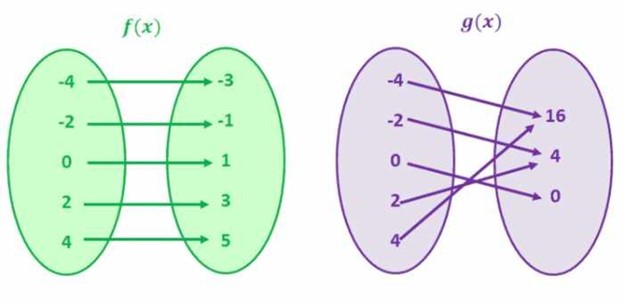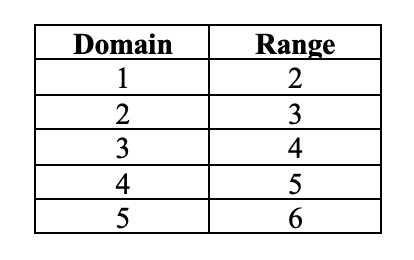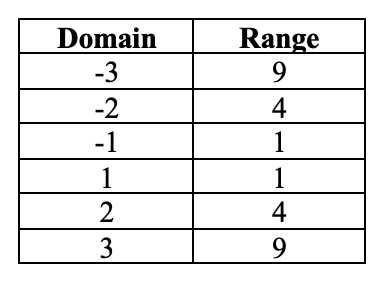One to One Functions - Graph, Examples | Horizontal Line Test
What is a One to One Function?
A one-to-one function is a mathematical function whereby each input correlates to a single output. So, for every x, there is only one y and vice versa. This implies that the graph of a one-to-one function will never intersect.
The input value in a one-to-one function is noted as the domain of the function, and the output value is noted as the range of the function.
Let's look at the images below:

For f(x), each value in the left circle corresponds to a unique value in the right circle. Similarly, every value on the right side correlates to a unique value in the left circle. In mathematical terms, this means that every domain owns a unique range, and every range owns a unique domain. Hence, this is a representation of a one-to-one function.
Here are some additional representations of one-to-one functions:
-
f(x) = x + 1
-
f(x) = 2x
Now let's examine the second picture, which displays the values for g(x).
Notice that the inputs in the left circle (domain) do not have unique outputs in the right circle (range). For example, the inputs -2 and 2 have equal output, in other words, 4. Similarly, the inputs -4 and 4 have identical output, i.e., 16. We can discern that there are equivalent Y values for multiple X values. Therefore, this is not a one-to-one function.
Here are different examples of non one-to-one functions:
-
f(x) = x^2
-
f(x)=(x+2)^2
What are the characteristics of One to One Functions?
One-to-one functions have the following properties:
-
The function owns an inverse.
-
The graph of the function is a line that does not intersect itself.
-
The function passes the horizontal line test.
-
The graph of a function and its inverse are the same concerning the line y = x.
How to Graph a One to One Function
When trying to graph a one-to-one function, you will have to find the domain and range for the function. Let's study an easy representation of a function f(x) = x + 1.

Immediately after you know the domain and the range for the function, you need to plot the domain values on the X-axis and range values on the Y-axis.
How can you evaluate if a Function is One to One?
To prove if a function is one-to-one, we can use the horizontal line test. Once you chart the graph of a function, draw horizontal lines over the graph. If a horizontal line moves through the graph of the function at more than one spot, then the function is not one-to-one.
Since the graph of every linear function is a straight line, and a horizontal line doesn’t intersect the graph at more than one point, we can also reason that all linear functions are one-to-one functions. Remember that we do not use the vertical line test for one-to-one functions.
Let's study the graph for f(x) = x + 1. Once you chart the values to x-coordinates and y-coordinates, you have to examine whether or not a horizontal line intersects the graph at more than one spot. In this example, the graph does not intersect any horizontal line more than once. This means that the function is a one-to-one function.

On the contrary, if the function is not a one-to-one function, it will intersect the same horizontal line more than once. Let's look at the diagram for the f(y) = y^2. Here are the domain and the range values for the function:

Here is the graph for the function:

In this case, the graph crosses multiple horizontal lines. Case in point, for both domains -1 and 1, the range is 1. Similarly, for either -2 and 2, the range is 4. This implies that f(x) = x^2 is not a one-to-one function.
What is the inverse of a One-to-One Function?
Since a one-to-one function has only one input value for each output value, the inverse of a one-to-one function also happens to be a one-to-one function. The opposite of the function essentially reverses the function.
Case in point, in the case of f(x) = x + 1, we add 1 to each value of x for the purpose of getting the output, in other words, y. The inverse of this function will remove 1 from each value of y.
The inverse of the function is denoted as f−1.
What are the properties of the inverse of a One to One Function?
The qualities of an inverse one-to-one function are the same as every other one-to-one functions. This signifies that the reverse of a one-to-one function will hold one domain for every range and pass the horizontal line test.
How do you figure out the inverse of a One-to-One Function?
Figuring out the inverse of a function is very easy. You simply need to swap the x and y values. Case in point, the inverse of the function f(x) = x + 5 is f-1(x) = x - 5.

As we reviewed earlier, the inverse of a one-to-one function reverses the function. Considering the original output value showed us we needed to add 5 to each input value, the new output value will require us to subtract 5 from each input value.
One to One Function Practice Examples
Consider the subsequent functions:
-
f(x) = x + 1
-
f(x) = 2x
-
f(x) = x2
-
f(x) = 3x - 2
-
f(x) = |x|
-
g(x) = 2x + 1
-
h(x) = x/2 - 1
-
j(x) = √x
-
k(x) = (x + 2)/(x - 2)
-
l(x) = 3√x
-
m(x) = 5 - x
For every function:
1. Figure out if the function is one-to-one.
2. Graph the function and its inverse.
3. Find the inverse of the function mathematically.
4. Specify the domain and range of every function and its inverse.
5. Use the inverse to solve for x in each calculation.
Grade Potential Can Help You Master You Functions
If you find yourself having problems using one-to-one functions or similar topics, Grade Potential can set you up with a private instructor who can support you. Our Fort Worth math tutors are experienced professionals who support students just like you improve their skills of these concepts.
With Grade Potential, you can work at your own pace from the comfort of your own home. Plan a meeting with Grade Potential today by calling (817) 774-4811 to find out more about our educational services. One of our consultants will call you to better inquire about your requirements to set you up with the best tutor for you!




